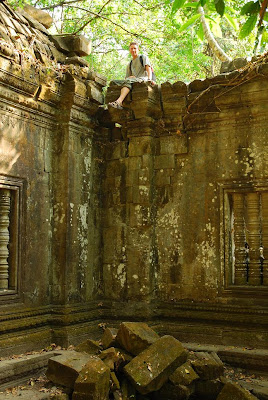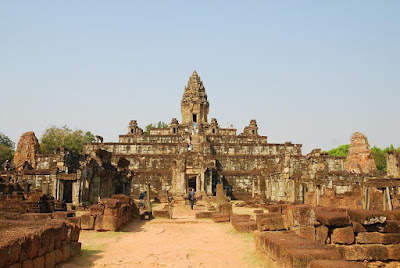Beng Mealea, a 12th century temple about 40km from the Angkor sights, is a large temple that has been left to the elements. Unlike at Ta Prohm, underbrush is not cleared on the temple grounds. Also, no area of the grounds is restricted, so one, at their own risk, can explore Indiana Jones-style wherever they would like. The unregulated visit coupled with the fact that tour buses didn't get there until late in the day made Beng Mealea the best temple visit of the Angkor region.
A wooden walkway winds through the temple; however, local temple staff immediately encouraged us to blaze our own path. We entered Beng Mealea via the wooden walkway where a temple groundskeeper was sweeping the walkway clear of fallen foliage. We were the first visitors of the day. As we peered curiously into the doorway of the temple gallery, the groundskeeper approached us and said "Enter...Enter...OK...OK." We peered once again at the fallen rubble, then at each other, before deciding this was too great an opportunity to pass up. Laura and I hopped over monolithic carved stone fallen from the high wall or ceiling. Eventually, we arrived into a long hallway that was still completely intact, ceiling, walls, and windows. The long corridor was lit only by daylight that filtered through the Khmer windows.
As we returned back to the entrance doorway, we realized the rubble could be scaled to the top of the walls where a new path could be blazed. This gave us an awesome outer view of the corridor we had entered.
Beng Mealea's retaining walls engulf 180 square meters. That's nearly two football fields long for each of the four walls. Access is completely unrestricted so one can explore uninhibited.
Scale the rubble...
Get lost among the temple walls...
Peer through ancient Khmer windows...
Enjoy the temple grounds from the highest walls still standing...
and loot mercilessly...
It's a real Indiana Jones/Lara Croft experience.
Around each corner, it felt like we were discovering a new treasure.
In the days of the Khmer Rouge, Beng Mealea was the most heavily mined temple. For decades, the temple was abandoned due to the mine danger. Eventually, as tourism to Angkor wat exploded, the decision was made to demine the temple. Today, it is mine-free. A walkway has been built for tour groups to enjoy Beng Mealea, but for those inclined to climb through the windows, hop up on the walls, or peer through a blocked doorway, you'll be rewarded for your efforts.
Hopefully, the remoteness of Beng Mealea will prevent it from becoming overcrowded and overwhelmed. This would surely lead to regulating visits to ensure the temple doesn't get destroyed and visitor safety. Now, it's a peaceful, unique adventure far different from the other Angkor temples.
As for the rest of the temples at Angkor, one could narrow the temples down into two major categories. One category is the pyramidal style temple. This essentially is a mound of carved stone culminating with a tower sanctuary at the top. The Bakong temple of the Rouluos group is a good example of this style.
The second category is a walled and often moated temple with long corridors leading from each of the cardinal directions to the center. Banteay Kdei and Preah Khan were examples of this style.
The dark corridors and hidden rooms of these temples make them the most fun to visit and explore.
Among the most unique of the temples was Banteay Srei (Citadel of the Woman).
This temples is aptly named for its beautiful, fine carvings, so fine they must have been done by women.
Unfortunately, the citadel is confined to small grounds and more than ten visiting tour buses made it nearly impossible to visit. Also very unique was the huge tree overwhelming the eastern gate of the temple Ta Som.
Now that we have visited the Angkor temples we will explore the city of Siem Reap in the coming days.
Now, a break from the travel blog to discuss getting around the Angkor temples. There are three main methods people use to visit the temples. Method one is to book a tour bus with a tour agency; this is the most expensive option but offers a good guide and a complete itinerary. Unfortunately, you visit at the most populated hours and share the experience with a crowd. Method two is to rent a bicycle and peddle temple to temple. The roads are flat, the temples aren't too spread out, but the heat of midday is enough to cause heatstroke. You'll be drenched and purchase liters of water. The most popular choice for individual travelers is the tuk-tuk. The issue is the tuk-tuk driver. We've avoided tuk-tuk drivers like the plague. They are master negotiators (for your money) making it such that even when you think you've won, you've lost. They take advantage of all ranges of emotion, from empathy to sorrow to happiness, for the extra dollar. My heart is hardened towards these street savy motorists, but Laura's heart aches after each sorrowful plea for the extra dollar. Somehow, they always seem to get it.
When we arrived in Siem Reap, a tuk-tuk driver gave us a free ride to the guesthouse for the opportunity to discuss an Angkor tour. After a half hour of negotiating, we arrived at $3 for Angkor sunset, $10 for first two days, and $15 for last day to the distant Banteay Srei. We shook and the deal was sealed, or so we thought. The next day we were picked up by his "brother" to see the sunset. We entered the tuk-tuk without discussing the previous day's arrived-at price. Everything went according to plan until we payed our driver $3. He said, "Price is $5." We argued back and forth, but his English was too poor (or so he pretended) to understand our argument. His brother, of course, was unavailable in an unknown location. The best resolution Laura and I could come to was to pay the $5, sever ties with him, and go looking for a new driver.
We ended up finding Lucky
who gave us the Angkor tour for $40, $5 more than we had originally bargained for. Lucky was difficult to manipulate for itinerary and getting-started time, but admittedly, he did arrive at the hour we finalized with him and his suggested itineraries were excellent. He always conveniently brought us to restaurants which charged double the average price for food and for reward, he'd be munching a free lunch in the back of the restaurant.
Much to my dislike, most of the sights and activities are too far outside of Siem Reap to walk or even bike. Rental vehicles often bring issues with police or even robberies, so we weren't adventurous enough to explore that option. Every activity meant dealing with a tuk-tuk driver, and that led to daily surprises and disagreements regarding our wallets. Now, I can only wonder what's in store for our visit to the silk farm tomorrow.

















2 comments:
who would have ever thought that you two would be climbing around the ruins of a temple in Cambodia; hope the Mummy didn't come to mind to you as did Indiana Jones and Laura Croft. By the way when do you guys take time to do laundry or are there plenty of "Chinese" laundramats in these areas you visit? Tut-tut drivers probably have wives or sisters that do that for you as the driver carts you around to various sites?? DAD
Hey Dad, there are tons of places for laundry and they charge about $1 per kilo. So, maybe once a week we get our laundry done for $3-4. It's always great to recieve all clean clothes. That's been much better than doing it by hand as we did in Africa.
Post a Comment